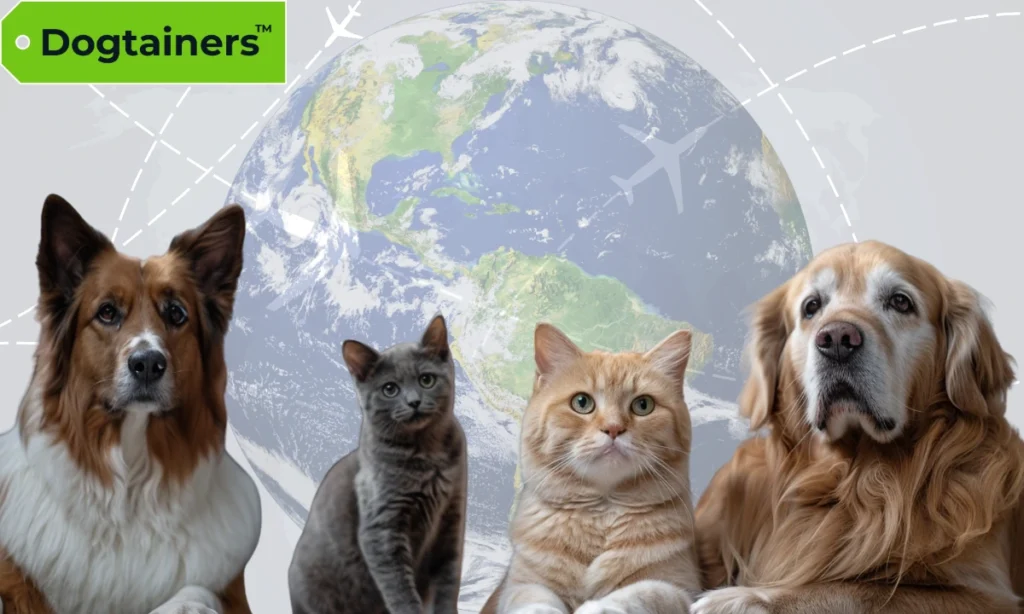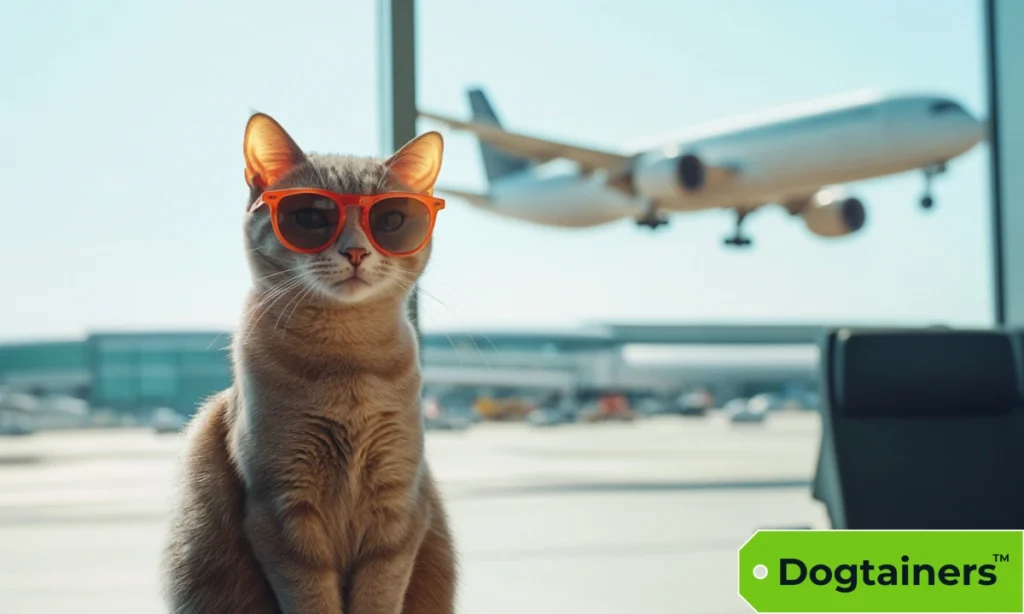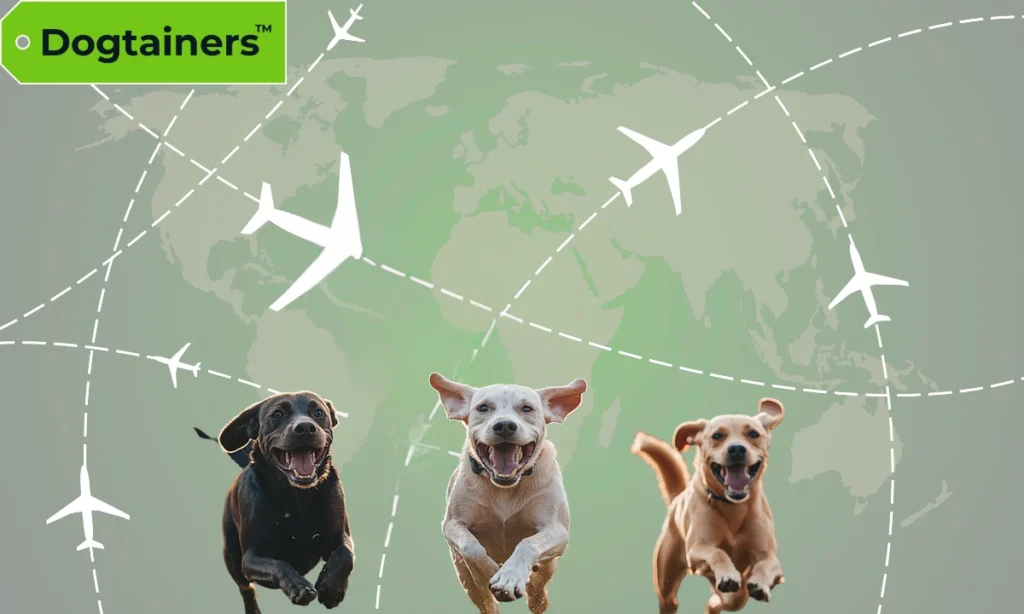Have you ever flown to Australia? You get a declaration form to complete on the plane before you land.
The form asks if you’re bringing anything into the country that might harm the native environment.
- Plants
- Animal products
- Even sports gear that might contain soil
Australia is renowned for its stringent biosecurity measures. These extend to quarantine regulations for pets entering the country.
Understanding Australian pet quarantine requirements is crucial when bringing your pet into the country. These rules protect local wildlife and domestic animals from potential diseases and pests being introduced.
Navigating the maze of quarantine requirements can be daunting.
But don’t worry. Because we’re here to help.
Understanding Pet Quarantine in Australia
Quarantine periods depend on the country your pet travels from. Your pets can enter Australia from approved countries. These countries fall into three categories: Group I, Group II, and Group III.
If you’re travelling from a non-approved country, you must transport your pet to an approved country first. Your pet must spend a set amount of time there before travelling to Australia.
The table below shows the country categories.
| Group | Countries/Regions |
| Group I | New Zealand, Norfolk Island, Cocos Island |
| Group II | American Samoa, Bahrain, Barbados, Christmas Island, Cook Island, Falkland Islands, Micronesia, Fiji, French Polynesia, Guam, Hawaii, Iceland, Japan, Kiribati, Mauritius, Nauru, New Caledonia, Niue, Palau, Papua New Guinea, Samoa, Singapore, Solomon Islands, Tonga, Tuvalu, Vanuatu, Wallis and Futuna |
| Group III | Antigua & Barbuda, Argentina, Austria, Bahamas, Belgium, Bermuda, British Virgin Islands, Brunei, Bulgaria, Canada, Canary and Balearic Islands, Cayman Islands, Chile, the Republic of Croatia, the Republic of Cyprus, Czech Republic, Denmark, Finland, France, Germany, Gibraltar, Greece, Greenland, Guernsey, Hong Kong, Hungary, Ireland, Isle of Man, Israel, Italy, Jamaica, Jersey, Kuwait, Latvia, Lithuania, Luxembourg, Macau, Malta, Malaysia (Peninsular, Sabah and Sarawak only), Monaco, Montenegro, the Netherlands, Netherlands—Antilles & Aruba, Norway, Poland, Portugal, Puerto Rico, Qatar, the Republic of South Africa, Reunion, Saipan, Serbia, Seychelles, Slovakia, Slovenia, South Korea, Spain, St Kitts and Nevis, St Lucia, St Vincent & the Grenadines, Sweden, Switzerland (including Liechtenstein), Taiwan, Trinidad and Tobago, the United Arab Emirates, the United Kingdom, the United States (including the district of Columbia, Northern Mariana Islands, Puerto Rico and the US Virgin Islands (but excluding Guam and Hawaii), Uruguay |
All pets, primarily dogs and cats, arriving from overseas must undergo quarantine, except those coming directly from New Zealand, Norfolk Island, and Cocos (Keeling) Island.
The Australian Department of Agriculture, Fisheries and Forestry sets the quarantine rules. These include:
- A mandatory health examination upon arrival
- Verification of documentation
- A quarantine period at the Mickleham facility in Melbourne
What is Pet Quarantine and Why is it Necessary?
Quarantine is a mandatory isolation period for animals when bringing pets to Australia. Authorities designed quarantine to prevent the introduction and spread of infectious diseases.
During quarantine, authorities monitor pets closely for signs of illness and vets administer any necessary care. This process is crucial because Australia is free from many animal-related diseases found elsewhere, such as rabies.
Quarantine helps maintain this rabies-free status. Overall, the regulations protect local wildlife, the agricultural industry and public health.
Australia’s Quarantine Laws for Pets
Australia’s quarantine laws for pets are some of the strictest in the world. The Department of Agriculture, Fisheries and Forestry outlines specific requirements that must be met before pets can enter the country.
Even before quarantine, your pets may need to meet certain requirements. These include:
- Valid import permit: You must get a valid import permit for your pets before they can be brought into the country.
- Microchipping: All cats and dogs must be microchipped and the microchip must be registered with an approved database.
- Vaccinations: All dogs and cats must be vaccinated against rabies, distemper, hepatitis, parvovirus, and other diseases. The vaccination requirements may vary depending on the country of origin.
- Health certificates: All pets must have a valid health certificate issued by an accredited vet in the country of origin. The health certificate must confirm that the pet is healthy and free from any infectious diseases.
- Parasite treatments: Pets must be treated for internal and external parasites, such as fleas and ticks, before entering quarantine.
- Transport crate: Pets must be transported in a suitable transport crate that meets the requirements set out by IATA.
- Booking at a quarantine facility: Owners must book their pet’s quarantine in advance. Quarantine spots can sell out, so it’s important to book your pet’s stay early.
- Pay all Mickleham Quarantine fees: Pet owners must pay all quarantine fees in full before their pet can be released from the Mickleham Quarantine Facility. The fees will depend on the length of the quarantine period.
- Schedule a release appointment: Pet owners must schedule a release appointment with the Mickleham Quarantine Facility in advance to ensure a smooth and timely release of their pet. This appointment will also allow pet owners to obtain all necessary documentation and information about their pet’s stay in quarantine.
- Plan for pickup or post-quarantine pet transportation: Pet owners must arrange their pet’s pickup or post-quarantine transportation – we can offer this with our door-to-door service.
A pet transport company like Dogtainers can help you make any necessary arrangements for pet travel.
We help you:
- Navigate the complex process of preparing your pets for quarantine, including providing advice on required documentation, vaccinations, and health checks
- Arrange transport to and from the quarantine facility, including providing transport crates that meet the mandatory requirements.
- With customs clearance, other logistical details, and ensure a stress-free and successful quarantine process for you and your pets
Quarantine and Disease Prevention
Quarantine plays a pivotal role in Australia’s biosecurity by acting as a barrier. The process prevents potentially harmful pathogens from entering the local ecosystem.
Isolating pets upon arrival lets authorities monitor them. They can detect and manage any health issues before the animals interact with the native species or the general public.
This system has been instrumental in keeping diseases like rabies out of Australia. Quarantine ensures the safety of Australia’s unique biodiversity and the health of its people and domestic animals.
Dog Quarantine Australia
How Long Do Dogs Have to Quarantine in Australia?
The quarantine period for dogs entering Australia ranges from 10 to 30 days, provided they meet all pre-entry conditions. The exact duration can vary based on factors such as the dog’s country of origin and the preparation completed before departure.
Preparation includes vaccinations, blood tests, parasite treatments, etc. Compliance with all pre-entry vaccination and treatment protocols is crucial to ensure the quarantine period remains as brief as possible for your pet.
Procedures and Regulations for Dog Quarantine
Upon arrival in Australia, dogs undergo a series of checks. Authorities monitor them to ensure they’re not carrying any diseases harmful to the local environment.
The quarantine process involves:
- A thorough health check of your dog, including blood tests
- External screening for parasites like fleas and ticks
The process ensures your dog is healthy, free from infectious diseases and isn’t carrying parasites that can introduce harmful diseases to Australia.
Preparing Your Dog for Quarantine
You need to plan your travel to Australia well in advance. We recommend at least six months.
Adhere to the vaccination schedule, including the rabies vaccination. Also, make sure you have a valid rabies titre test, internal and external parasite treatments, and a microchip for identification.
Always comply with all of the quarantine requirements. Failure to do so can result in authorities refusing entry for your pet.
Can I Visit My Dog in Quarantine in Australia?
No, you can’t visit your dog when it’s quarantining in Australia. The rules around visiting pets in quarantine are strict to maintain the integrity of the biosecurity process.
Visiting pets in the Mickleham Post Entry Quarantine Facility in Melbourne is forbidden. This policy minimises the risk of disease transmission and maintains a controlled environment.
Restricting visitation also benefits your dog. Because your dog could get stressed if you visited then left – they wouldn’t understand why you’re leaving without them.
Cat Quarantine Australia
Quarantine Requirements for Cats
The quarantine requirements for cats in Australia are also stringent. Cats must be microchipped, vaccinated against rabies, and have a series of tests, including a rabies titre test, before entering Australia.
They must also undergo treatment for internal and external parasites. All these requirements must be documented and presented upon arrival in Australia. Cats that meet all pre-entry requirements will be placed in quarantine upon arrival.
The only exception is cats travelling from New Zealand, Norfolk Island, and Cocos Island. Pets from these countries only require clearance upon arrival – we can help with that.
How Long Do Cats Have to Quarantine in Australia?
Similar to dogs, cats must undergo a quarantine period of 10 to 30 days in Australia. Your cat needs to spend at least 10 days in quarantine, which can get extended depending on the circumstances.
The 10-day period allows for sufficient observation. Authorities can ensure that your cat isn’t carrying any diseases or parasites harmful to Australia.
The quarantine period may be extended from 10 to 30 days if any health concerns arise during monitoring.
Preparing Your Cat for Quarantine
Planning your travel to Australia well in advance is crucial. We recommend starting at least six months before departure.
Follow the vaccination schedule, including the rabies vaccination. Have a valid rabies titre test, internal and external parasite treatments, and a microchip for identification.
Always comply with all of the quarantine requirements. Failure to do so can result in authorities refusing entry for your cat or even exportation.
Can I Visit My Cat in Quarantine in Australia?
No, you can’t visit your cat in quarantine in Australia. Strict rules surround visiting pets in quarantine to maintain the integrity of the biosecurity process.
Visiting your cat in the Mickleham Post Entry Quarantine Facility is prohibited. Authorities put the policy in place to minimise the risk of disease transmission and maintain a controlled environment.
Animal Quarantine Australia
What Should I Expect During My Pet’s Quarantine?
During quarantine, your pet is housed in a secure, government-approved facility. Authorities monitor them for signs of disease.
Your pet gets regular feeding, exercise, and access to veterinary care. The facilities are designed to minimise stress, with protocols to ensure your pet’s well-being.
What Food Will My Pet Get in Post Entry Quarantine?
PEQ by default only feeds pets once a day and it’s dry food.
So if they eat twice a day, prefer wet food or a combo of both, or have dietary requirements. Contact PEQ and get their Animal Care Declaration filled out.
Australian Quarantine food provided is as follows, in case you want to prepare your pet or they’re fussy.
DOG
Dry food:
- Royal Canin Mini Adult
- Royal Canin Medium Sensible
- Royal Canin Medium Puppy
- Royal Canin Hypoallergenic
Wet food:
- Royal Canin Medium Sensible
- Royal Canin Puppy
CAT
- Royal Canin Indoor Cat (dry)
- Royal Canin Kitten (dry and wet food)
- Royal Canin Indoor Pouch
- Royal Canin Sensible Dry
- Royal Canin Sensitivity (dry and wet food)
Can I Send Specific Food for My Pet?
Yes, you can send specific food to the quarantine facility for your pet. But there are some guidelines to follow.
You must source the pet food from Australia and send it to the quarantine facility before arrival. The package must be labelled clearly with:
- Pet’s name
- Permit number
- Pet importer’s name
Food sourced from Australia can be released with your pet. Sending it 2-3 weeks before your pet’s arrival would be ideal. Include some buffer time to react in case the delivery goes AWOL.
You can order food from the below pet shops in Australia (these are the most common):
- My Pet Warehouse
- Petbarn
- Petstock
Ensure that you include your pet’s name on the address, and send it to:
Department of Agriculture, Fisheries and Forestry
ATT: ‘DOG NAME’ IP000 number | PRN: 0number
135 Donnybrook Road Mickleham Victoria 3064
Don’t send food along with your pet. Authorities destroy any food sent with animals upon arrival due to the possible biosecurity risks associated with the food.
How Much Does Pet Quarantine in Australia Cost?
For a 10-day quarantine period, we estimate around AUD 2,000 per animal. But costs can vary based on additional treatments or extended stays.
Quarantine fees are governmental costs – transport companies like Dogtainers don’t set these fees.
Conclusion
Pet quarantine in Australia is an essential part of bringing your pets to Australia. The regulations protect the natural environment, Australian pets and local people.
The quarantine process is strict. Always follow the pre-entry requirements to ensure a stress-free trip.
We can help you prepare for bringing your pets to Australia. Our expertise in the pet transport industry extends for 50+ years.
Our dedicated team has helped bring 1000s of pets into Australia. Remember, it takes preparation, and we advise you to start at least six months in advance.
All that preparation is worth it.
Reuniting with your pet after the quarantine period is a beautiful moment. And you can start experiencing pet-friendly activities in Australia with your furry companion.





Share this article